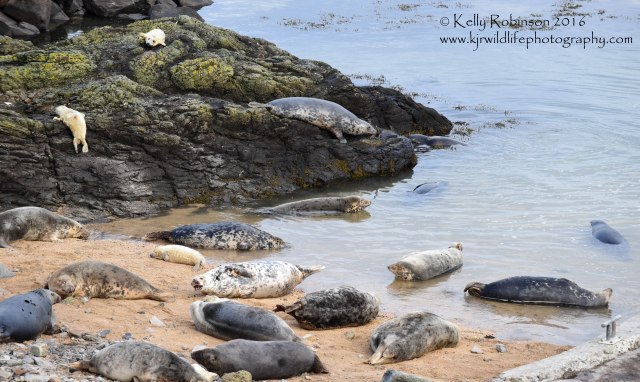
We now have a Twitter feed! Please follow us @KJRScience for more photos, news and #IslandLife shenanigans!
The first week of our stay on the Isle of May grey seal breeding colony has flown by, and the number of mother – pup pairs is growing daily. The PHATS team from Abertay University and the Sea Mammal Research Unit, University of St Andrews is still waiting for our first sampling opportunity before we can start work, looking at persistant organic pollutants (POPs) and how they affect fat tissue function in seals. We will get the chance to start our sample collection in about a week, when the pups are almost ready to wean from their mothers and are large and fat (see the previous blog for more details about our sampling regime). While we wait both Holly and I are helping survey the colony regularly by doing observations of the seals arriving and looking to see if any seals are study individuals. Study individuals are females that have been included in the Isle of May grey seal research project for many years, and they usually have small flipper tags to help us identify them. Female grey seals typically come back to the same colony to give birth, and as they have spotty patterns on their fur that stay the same throughout their lives, we can identify the same females year after year and build up long term datasets of what happened to them across many years.


All the other research projects on the Isle of May are in full swing, as they are interested in the seals from when the pups are born right through to weaning. For example, Dr Sean Twiss is leading a team here from Durham University studying the maternal behaviour of grey seals and how it can be linked to physiological metrics like heart rate data from novel, external loggers they designed and built themselves (read more about their research here). There is always plenty going on to observe in the colony, never a dull moment! Here are a few of the behaviours you can see currently on the Isle of May breeding colony:
Births
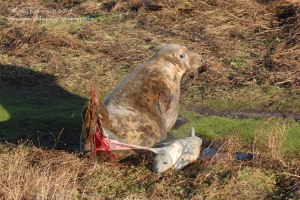
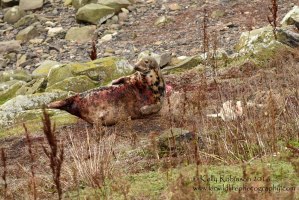
Grey seal births are extremely rapid and can be tricky to see. After the birth, mothers will sniff their pup and bond with it so they can stay together for the coming weeks on the busy colony. Newborn pups are pretty easy to spot as the mothers can be quite red from the blood lost during delivery and sea gulls come to scavenge the placenta to eat. Seal mothers do not always react well to this, and can spend lots of time chasing gulls away from themselves, their pup and the placenta. My PhD work was primarily on maternal behaviour and how mother-pup bonds form, and I always love watching births if I can spot one.

Nursing
Grey seal mothers only spend about 18 days with their pups before weaning them and going back to sea. In those 18 days it is vital for the pup to drink as much fat rich milk from the mother as possible, the larger a pup is at weaning the more likely it is to survive its first year of life. Grey seal milk is 60% fat so pups can put on weight very quickly, pups born at 18kg can easily reach more than 50kg in just over two weeks! Nursing bouts take about five minutes and happen approximately ever four hours throughout the day and night.

Defending the pup from other seals and gulls
A grey seal mother will aggressively defend her pup from anything that approaches too closely. Other female seals will attack any pup that is not their own and males will not tolerate pups in their personal space either. Without their mothers to defend them, pups soon become covered in bites from other adults. Sea gulls can also seriously injure, and in some cases kill, grey seal pups by pecking at their eyes and fresh umbilical. Mothers therefore do not tolerate gulls coming to close and will aggressively chase them away.
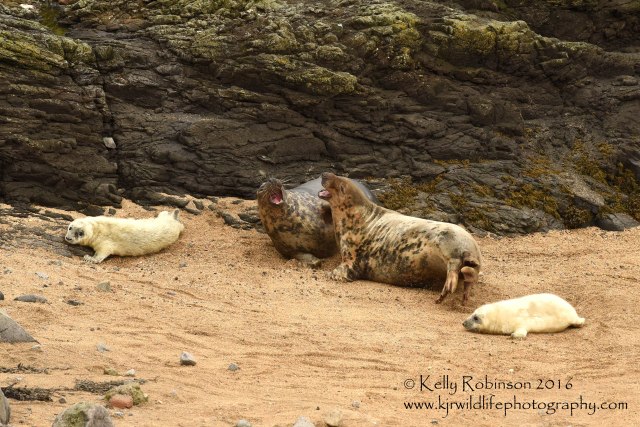
Male dominance fights
As the breeding season progresses, more male grey seals arrive on the colony to try and hold a position among the females, so that they can try to mate with them once the pups are raised. Males will threaten each other with hisses and open mouth threat displays, but many confrontations do not result in fights as these are dangerous and tiring for both parties. Sometimes however, neither male will back down and the two will fight brutal battles for dominance, biting and shaking each other’s necks and heads.
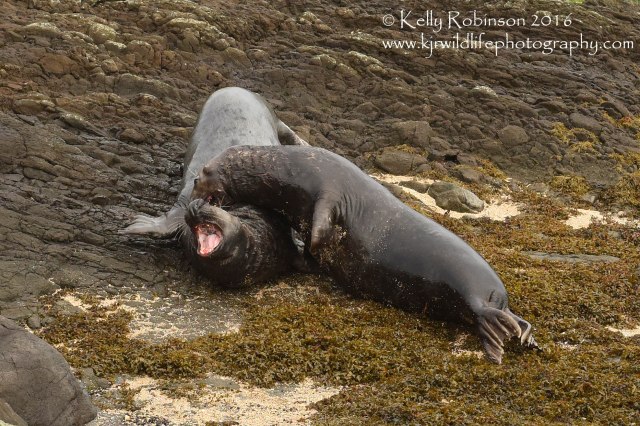
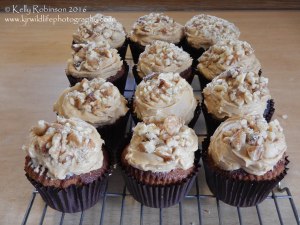
MEANWHILE away from the seals, the team on the Isle of May are enjoying island life as much as possible. The sunrises here are stunning and there are lots of amazing birds flying around to watch out for, the short eared owls are a particular favourite currently. Half of the team indulged in a rare TV night to join the rest of the nation in watching the Great British

Bake Off final, and as that put me in a baking mood I made some coffee and walnut cupcakes for everyone. We were joined yesterday by the leader of the PHATS team, Dr Kimberley Bennett fresh from teaching at Abertay University and she brought some fresh food supplies, even more lab gear and halloween goodies! Cue some epic pumpkin carving by Holly and fellow research assistant Izzy, now to put them somewhere high so the mice don’t attack them in the night!

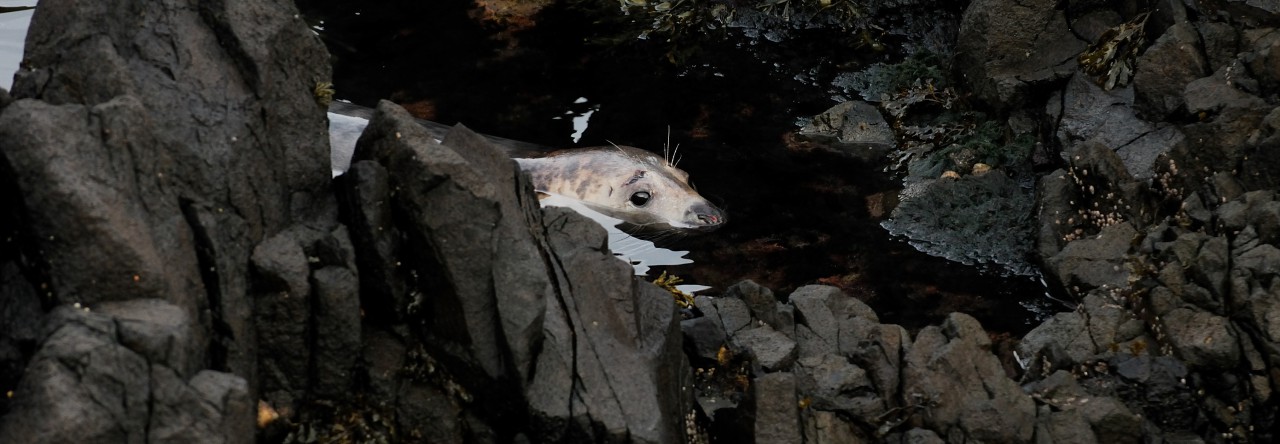
Cool pumpkins – are you planning to watch the fireworks from the lighthouse on Saturday? Say ‘Hi’ Sean and Kimberley 🙂
LikeLike
Hi Paula! Big hugs from the island, yep I think we’re all going to head up to the main light to see if we can spot fireworks on the mainland, here’s hoping we’ll get a clear night for it!
LikeLike
Recently been videoing Grey seals in Norfolk and noticed that several of the mothers with young pups had an attendant black backed gull usually a juvenile which spent a lot of time within a couple of metres of the pair and seemed to be tolerated. Every so often it would approach the rear of the juvenile and peck it several times (never near the eyes or umbilical) Sometimes it would appear to eat something but not always. The youngster would move away a few feet and the process would begin again once the pup had settled. On one occasion the gull did the same to the mother. Is this a way of keeping the pup and beach clean by eating the faecal matter? Could only find ref to gulls pecking eyes on internet.
Dave bevan
LikeLike
Dear Dave,
Thank you for your comment, it is quite common for gull species to approach young grey seal pups, especially if the pup or mother is asleep. They most commonly do peck the eyes and the umbilical of pups, these are the softest targets and it’s how gulls open up dead pup carcasses to scavenge meat from. Depending on how large and bold the gull is, and how attentive the mother is, gulls also do this to live pups to kill them for food.
It is unusual if they are avoiding those areas of the body but not unheard of, I have observed some gulls peck at the back or rear flippers of a pup repeatedly on colonies in Scotland, causing the pup to move and then repeating the process as you describe. Its not clear why they were doing this but the gulls will be motivated by looking for food, repeatedly harassing the pup in this way does tire them out and may make them more susceptible to predation, especially if the pup is being driven away from it’s mother’s side and her protection. As for eating faecal matter, I’ve not seen gulls do this with grey seals nor heard any reports of it, but they are opertunisitic and I’ve seen gulls eat pup vomit before and peck at the rear flippers of adult females after birth to get bits of blood or placenta. There are sea birds that feed extensively on seal faeces on breeding colonies but they are not found in the UK, birds like Caracaras in the southern hemisphere for example do this alot.
Sorry I can’t offer any more of an explaination, and thanks again for getting in touch!
LikeLike